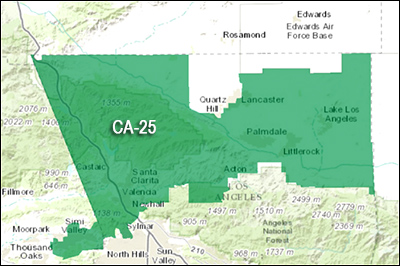By Jim Ellis

California Congressional District 25
In the special California primary held on March 3, a dozen candidates, six Democrats and six Republicans, battled one another either to secure majority support or one of two runoff positions for the May 12 runoff vote. Under California election law, if a candidate attracts majority support, the individual would be elected outright to serve the balance of the current term. If not, the top two finishers, regardless of political party affiliation, advance to a runoff election. It is the latter scenario that occurred here.
In addition to the special election, a second vote was held on March 3 for the regular succeeding term. In this contest, 13 candidates were on the ballot, the 12 aforementioned contenders along with Independent Otis Lee Cooper.
Not surprisingly, the two individuals finishing first in the special election also qualified for the general election. They are: freshman state Assemblywoman Christy Smith (D-Newhall) and defense contractor and Iraq War veteran Mike Garcia (R). The election totals in the two contests are somewhat different, however.
The final totals are still not tabulated. According to the Secretary of State’s office, 313,739 ballots statewide remain uncounted with virtually no progress being made last week. In the 25th District, approximately 5,500 votes await counting in order to be added to the published totals. The final tabulation will not change the first- and second-place finisher status, however.
Interestingly, despite the special and regular vote being held at the same time and on the same ballot, almost 4,000 more people voted in the special election than in the regular primary. Percentage-wise, approximately 39 percent of the district’s registered voters cast a ballot in the special while 38 percent did so for the regular primary. Statewide, the turnout measured just under 45 percent of the registered voters for the regular primary that included a contested Super Tuesday presidential vote.
In the regular election, Smith finished first with 31.8 percent of the vote as compared to Garcia’s 23.9 percent, an unofficial difference of 12,211 votes. In third place came former US representative, Steve Knight (R), with 19 percent. Knight held the seat for two terms but was defeated in 2018 at the hands of Hill, but clearly failed in his attempted political comeback in this election. Smith did significantly better in the special election, claiming first position with 36.1 percent as compared to Garcia’s 25.4 percent, a difference of 17,112 votes.
A new post-primary poll, however, suggests a potentially different special general outcome. The 1892 research organization released their latest data (500 CA-25 likely voter live interviews), which finds Garcia holding a 43-39 percent edge over Smith. The survey suggests that the vote totals between Smith and Garcia may not tell the entire story.
While Smith outpolled Garcia by better than 10 percentage points in the special primary election, the overall Democrat to Republican vote was a very tight 50.6 – 49.4 percent in favor of the former party. In the regular election total, the Republican vote actually exceeded that of the combined Democratic total, 51.1 – 48.9 percent.
The totals are not particularly surprising in that this San Fernando Valley congressional district had been in Republican hands in the person of former representatives Buck McKeon and Steve Knight since it was drawn in its present configuration back in 2011 … until Hill won the seat in 2018.
Additionally, the 1892 poll may have uncovered a campaign element for Garcia. Half of those questioned for the survey correctly identified Garcia as a retired Navy fighter pilot. Within this segment, the ballot test broke 69-26 percent in his favor, suggesting we will see an emphasis on his military background during the coming campaign period.
Additionally, the succeeding election calendar prompts further unanswered questions. The special election is scheduled for May 12, but will Gov. Gavin Newsom (D) move the vote because of COVID-19 virus precautions? Or, could he simply suspend the special vote as he did for California’s 50th District when GOP Rep. Duncan Hunter resigned? Again, he could use the COVID-19 situation as his reasoning for doing so.
If the governor were to either postpone or suspend the runoff, even more questions could arise since the vast majority of California voters cast their ballots through the mail. Though it is not yet known how many voted by mail versus in person on March 3, in the 2018 general election 65.3 percent of all votes were sent through the postal system according to the California Secretary of State’s Statement of the Vote report.
The Golden State’s 25th District contains parts of two counties, Los Angeles and Ventura, though less than 17 percent of the constituency lies in the latter entity. The district begins in the Simi Valley and stretches northeast into the city of Santa Clarita, then through the city of Palmdale, ending in and around the Lancaster municipality before moving further eastward.
Originally drawn as a Republican seat, the 25th has ventured to the left in the succeeding elections, consistent with voting patterns virtually throughout the state. The district features a 50.8 percent female population with 52.4 percent of the Citizen Age Voting Population being non-Hispanic white, 29.0 percent Hispanic, 8.1 percent black, and 7.7 percent Asian. The district residents have an average household income of $104,954 according to the latest US Census figures, and just under 29 percent hold a bachelor’s degree or higher.
